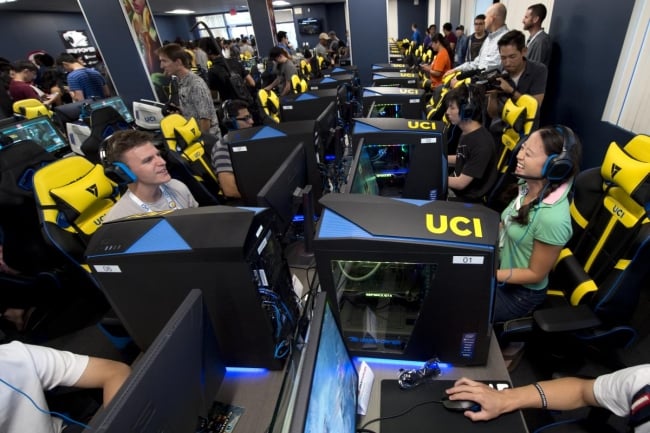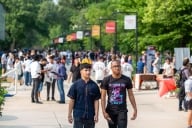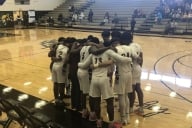You have /5 articles left.
Sign up for a free account or log in.

Students, faculty, staff members and guests use gaming equipment at the University of California, Irvine's esports arena before the coronavirus pandemic.
University of California, Irvine
While the coronavirus pandemic has caused uncertainty about whether college athletics programs will be able to compete this fall, it has also spurred some colleges to more aggressively market their competitive esports teams. But the pandemic has also stalled plans by some institutions to expand or create esports programs.
At a time when in-person gatherings and high-contact sports are discouraged by public health experts, esports can easily operate in a remote setting. All that's needed for students or fans to watch or participate in esports in most cases is a computer and internet connection.
The cancellation of spring athletics and the postponement of the fall season by many intercollegiate athletic conferences have sparked more interest in esports from institutions that sponsor strong traditional sports programs, said Michael Brooks, the executive director of the National Association of Collegiate Esports, or NACE, a nonprofit organization that provides resources, governance and competition structure for colleges with varsity esports teams or those looking to create one.
Esports are “operating in a pretty empty vacuum of what would normally be filled with news about football and the upcoming basketball season,” he said.
While this vacuum would seem to present new economic opportunities for colleges, the development of collegiate esports at colleges without such programs has also slowed due to budgetary constraints related to the pandemic, Brooks said. Some colleges that were working to create esports programs have put those plans “on pause,” he said. Meanwhile, the esports budgets of other colleges in NACE’s 170-institution membership have been cut.
“The reduction varies dramatically,” Brooks said. “Some have had a couple thousand cut off, some have delayed growth plans, some have had budgets dramatically cut.”
Ohio State University is delaying plans to introduce an interdisciplinary major in game studies, which would be one of the first undergraduate academic programs focused on esports at a public institution. The university initially intended to launch the major in fall 2020, but "given the COVID-19 pandemic, our timeline has been adjusted slightly," Rob Messinger, a spokesman for Ohio State’s Office of Academic Affairs, said in an email.
"But we plan to finalize the proposed major and hope to bring it forward for consideration in the upcoming academic year," Messinger wrote.
Although the start-up costs to create a bare-bones esports program -- without a huge arena for gameplay or expensive gaming equipment -- are lower compared to traditional sports, the current financial climate in higher education should call into question any investment in esports, said Anthony Hennen of the James G. Martin Center for Academic Renewal, a conservative public policy institute in North Carolina. Hennen, who has written about colleges’ investment in esports, said the programs have the potential to pay off for institutions but are now a much riskier investment, especially for small public institutions.
“I would hope there’s some people in the university saying that this is not the time to keep expanding,” Hennen said. “For bigger schools, it’s smart of them to be at the forefront of all this. But for these smaller regional schools, it’s much riskier for them.” Hennen said university boards of trustees would likely question the need for such programs and ask: "Why are you expanding into this when you're cutting English or philosophy professors?"
Hennen recalled how the University of Akron, a regional public institution in Ohio, planned to allocate $1.2 million for new esports facilities and operating costs in 2018 at the same time the university was cutting academic programs. The move was vocally opposed by faculty members. Budget cuts made by the university earlier this month resulted in the elimination of 97 full-time professors and were met with more faculty criticism that the university is prioritizing athletics over academics.
Pam Schulze, professor of child and family development at Akron and president of the faculty union, recalled the meeting two years ago during which the university's Board of Trustees announced the plan to renovate some buildings into esports facilities.
“It was at exactly the same board meeting where they cut 80 academic programs where they announced new spending on the sport,” Schulze said. “It’s esports, so that makes it different somehow. It’s still a sport, it’s athletics. It’s not academics … We can’t be the university of new, trendy, novelty things.”
Hennen said despite the potential for esports to increase institutions' revenue, either from increased enrollment by interested students or sponsorship deals, this has not yet occurred. He noted that colleges are also unlikely to see profits from traditional sports this year as many institutions and athletic conferences postpone or cancel sports programs in response to the pandemic.
“If any athletic competition or athletic marketing is more appealing right now with all the uncertainty, it’s esports,” Hennen said. “It’s much less risky than a lot of the alternatives.”
Some of the collegiate powerhouse conferences, for example, are beginning to experiment with esports competition through their broadcasting and marketing channels and are turning to NACE for guidance about how to get more involved in intercollegiate competition, Brooks said.
The Big 12, an NCAA Division I conference, hosted its first esports tournament earlier this month, which featured students from each of the conference’s member institutions competing in Madden NFL 20, a professional football simulation game that can be played on a Microsoft computer, PlayStation or XBOX gaming console. The tournament was broadcast on ESPN’s subscription-based streaming service and Twitch, a free internet streaming platform frequented by esports gamers and fans. The tournament even featured official play-by-play announcers that typically provide commentary during live college sports games at Big 12 institutions.
Learfield IMG College, a marketing company that manages the multimedia rights, ticketing, corporate sponsorship and advertising for more than 200 university athletic programs and conferences, sold sponsorships for the esports tournament, both at the institution level and for the Big 12, said Rob Schneider, chief content, development and strategy officer for the company. Schneider said the company has yet to see final total viewership numbers for the tournament. More than 250 students at the Big 12’s 10 universities signed up to participate, and 16 of them ultimately represented their institutions in playoff competition, he said.
“We’re in conversations with all our school partners at the university and conference level about more events like this,” Schneider said. “The reception has been overwhelmingly positive … This is the direction that college sports is headed regardless, and the environment that we’re in now is accelerating it in a way that we didn’t expect.”
More viewers watched the tournament on ESPN than Twitch, which Schneider said is a sign that the event appealed to more traditional sports fans. He noted that when it comes to monetizing collegiate esports, colleges and their marketing partners are still in the “early days” of determining how profitable such entirely online tournaments can be.
Brooks, of NACE, said right now, esports revenue “won’t come close to making up revenue for football and basketball.”
Bob Burda, senior associate commissioner of communications for the Big 12, said some of the sponsorship deals for the tournament made up for companies’ lost advertising opportunities as a result of the spring sports cancellation. The tournament was conducted at no cost to the conference or its member institutions, he added.
Burda said esports could produce some revenue for institutions and engage college sports fans, especially in the absence of live sports.
“There does seem to be an alignment there, as esports continue to grow, that fans of a particular sport have the tendency to migrate towards the electronic or gaming version of that sport,” Burda said.
While there’s hope that esports competition can be monetized, college athletic departments are not always the recipient of that revenue. Esports is not officially sponsored by the NCAA nor its athletic conferences, and many esports programs are housed in student affairs or activities departments.
The varsity esports team at the University of California, Irvine, which was launched in fall 2016, is housed under the university’s student affairs division, and any revenue the team earns is used within the esports program, said Mark Deppe, the program’s director.
Because live events and practices are also part of the esports experience, their cancellation will mean a loss of physical togetherness and the social aspects of college esports, Deppe said. Gaming competitions attract the most attention when people are packed into arenas to watch talented gamers compete in person, said Brandon Smith, esports director at Ohio State.
Deppe said esports arenas, such as the 3,500-square-foot facility at UC Irvine, are currently “all sitting there dark and empty” on campus, like other university buildings. UCI's arena will remain closed going into the fall, as undergraduate courses will be held almost entirely online. Deppe is co-hosting a webinar on July 30 centered around how esports programs can continue to operate remotely without bringing students physically together.
“Not having that arena that we invested in to show off is sad,” Deppe said. “Then there’s the lost camaraderie. I can’t underscore that enough.”
Smith said Ohio State's 80-seat esports arena will operate at reduced capacity in the fall when students are welcomed back to campus.
“Our students picked right back up on practice and competition through the spring,” Smith said. “We’ll have some physical spots for physical play this fall, but a lot of our community engagement in the program is going to be virtual … Our shift is to go back to esports’ common roots and go virtual. It’s a way to connect with community and engage students when they return back to school.”








